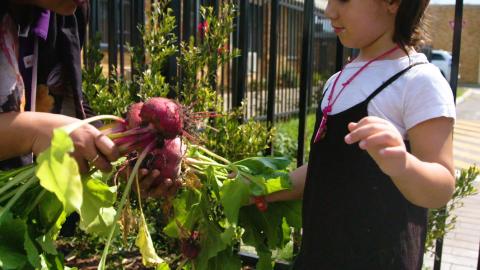Children develop numeracy and maths skills through everyday activities like counting, looking at shapes, and talking about sizes and patterns.

Curriculum
Early Years Learning Framework (ELYF)
- Children are connected with and contribute to their world
- Children are confident and involved learners
- Children are effective communicators
Number and algebra:
- Recognises, describes and continues repeating patterns. (MAE-FG-01)
- Forms equal groups by sharing and counting collections of objects. (MAE-FG-02)
- Develops understanding and fluency in mathematics through exploring and connecting mathematical concepts, choosing and applying mathematical techniques to solve problems, and communicating their thinking and reasoning coherently and clearly. (MAE-WM-01)
National Numeracy Learning Progressions (LPs)
Families
Read (2 mins)

Patterns help children learn sequencing and to make predictions which leads to mathematical skills and establishing order in life.
Exploring patterns is important for identifying many different kinds of mathematical relationships. It underpins memorisation of the counting sequence and understanding number operations, for instance recognising that if you add numbers in a different order their total stays the same.
Pattern awareness has been described as early algebraic thinking, which involves:
- noticing mathematical features
- identifying the relationship between elements
- observing regularities
Encourage children to describe, copy, represent and extend patterns found in everyday situations, and to create and describe their own patterns.
Explore (10 mins)

Some ideas for learning in the everyday:
- Explore the different patterns you find in nature. The patterns on a leaf. The number of petals on a flower. The clouds in the sky.
- Make a pattern with music – clapping, clicking, stamping.
- Make a pattern with fruit.
- Make a pattern with movement and follow the leader.
- Sort toys into categories, e.g. trucks, cars, planes.
- Make number patterns.
- Sort toys by shape, size or colour.
Teachers
Reflect (30 mins)

Reflect on your knowledge and practice. Consider the EYLF, NSW Curriculum and LPs:
- Where have these children come from?
- Where are you taking them?
Think about the learning happening in your classroom that builds the knowledge and skills for patterns.
What do you expect from the early learner?
What do you want parents to know about patterns?
How are patterns used across the curriculum?
Consider this skill – What are the connections between literacy and numeracy?
This is an opportunity to share what patterns looks like in your classroom.
Engage (45 mins)

Engage in a learning conversation with parents. Suggested conversation starters:
- Is there anything in the video that challenged your thinking about learning?
- What foundational skills did you see in the video?
- How are the children:
- Practising their skills?
- Testing their ideas?
- Building their knowledge?
- What opportunity can you create or do you have at home that
develops the use of patterns?